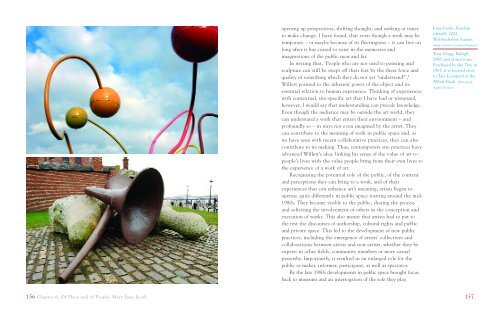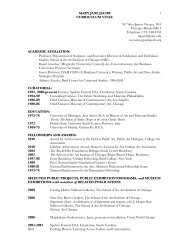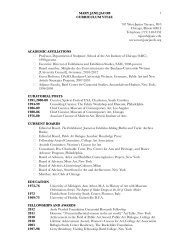Chapter 6. Of Place and of People. Mary Jane Jacob.
Chapter 6. Of Place and of People. Mary Jane Jacob.
Chapter 6. Of Place and of People. Mary Jane Jacob.
You also want an ePaper? Increase the reach of your titles
YUMPU automatically turns print PDFs into web optimized ePapers that Google loves.
opening up perspectives, shifting thought, <strong>and</strong> seeking at times<br />
to make change. I have found, that even though a work may be<br />
temporary – or maybe because <strong>of</strong> its fleetingness – it can live on<br />
long after it has ceased to exist in the memories <strong>and</strong><br />
imaginations <strong>of</strong> the public near <strong>and</strong> far.<br />
In writing that, ‘<strong>People</strong> who are not used to painting <strong>and</strong><br />
sculpture can still be swept <strong>of</strong>f their feet by the sheer force <strong>and</strong><br />
quality <strong>of</strong> something which they do not yet “underst<strong>and</strong>”’, 1<br />
Willett pointed to the inherent power <strong>of</strong> the object <strong>and</strong> its<br />
essential relation to human experience. Thinking <strong>of</strong> experiences<br />
with contextual, site-specific art that I have had or witnessed,<br />
however, I would say that underst<strong>and</strong>ing can precede knowledge.<br />
Even though the audience may be outside the art world, they<br />
can underst<strong>and</strong> a work that enters their environment – <strong>and</strong><br />
pr<strong>of</strong>oundly so – in ways not even imagined by the artist. They<br />
can contribute to the meaning <strong>of</strong> work in public space <strong>and</strong>, as<br />
we have seen with recent collaborative practices, they can also<br />
contribute to its making. Thus, contemporary site practices have<br />
advanced Willett’s idea, linking his sense <strong>of</strong> the value <strong>of</strong> art to<br />
people’s lives with the value people bring from their own lives to<br />
the experience <strong>of</strong> a work <strong>of</strong> art.<br />
Recognising the potential role <strong>of</strong> the public, <strong>of</strong> the content<br />
<strong>and</strong> perceptions they can bring to a work, <strong>and</strong> <strong>of</strong> their<br />
experiences that can enhance art’s meaning, artists began to<br />
operate quite differently in public space starting around the mid-<br />
1980s. They became visible to the public, sharing the process<br />
<strong>and</strong> soliciting the involvement <strong>of</strong> others in the conception <strong>and</strong><br />
execution <strong>of</strong> works. This also meant that artists had to put to<br />
the test the discourses <strong>of</strong> authorship, cultural rights <strong>and</strong> public<br />
<strong>and</strong> private space. This led to the development <strong>of</strong> new public<br />
practices, including the emergence <strong>of</strong> artists’ collectives <strong>and</strong><br />
collaborations between artists <strong>and</strong> non-artists, whether they be<br />
experts in other fields, community members or more casual<br />
passersby. Importantly, it resulted in an enlarged role for the<br />
public as maker, informer, participant, as well as spectator.<br />
By the late 1980s developments in public space brought focus<br />
back to museums <strong>and</strong> an interrogation <strong>of</strong> the role they play.<br />
Jorge Pardo, Penelope<br />
(detail), 2002,<br />
Wolstenholme Square.<br />
(Image courtesy <strong>of</strong> Liverpool Biennial)<br />
Tony Cragg, Raleigh,<br />
1986, metal <strong>and</strong> stone.<br />
Purchased by the Tate in<br />
1987, it is located close<br />
to Tate Liverpool at the<br />
Albert Dock. (Photograph,<br />
Angela Mounsey)<br />
156 <strong>Chapter</strong> <strong>6.</strong> <strong>Of</strong> <strong>Place</strong> <strong>and</strong> <strong>of</strong> <strong>People</strong>. <strong>Mary</strong> <strong>Jane</strong> <strong>Jacob</strong><br />
157





